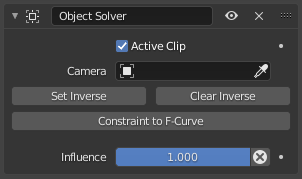Object Solver Constraint
The Object Solver constraint gives the owner of this constraint, the location and rotation of the "solved object motion".
The "solved object motion" is where Blender thinks the physical, real-world (tracked) object was, relative to the camera that filmed it.
Can be used to add a mesh to video for example.
Catatan
This constraint only works after you have set up a minimum of eight markers and pressed Solve object Motion. Located at .
If it says Solve Camera Motion instead of Solve Object Motion then go into the and switch it from the camera, to an object.
Options

Object Solver Constraint panel.
- Active Clip
Receive tracking data from the active movie clip in the Movie Clip editor. If unchecked, an option appears to choose from the other clips.
- Object
Select a tracked object to receive transform data from.
- Camera
Select the camera to which the motion is parented to (if left empty the active scene camera is used).
- Set Inverse
Moves the origin of the object to the origin of the camera.
- Clear Inverse
Moves the origin of the object back to the spot set in the Movie Clip Editor .
- Constraint to F-Curve
Applies the constraint, creating keyframes for the transforms.
- Influence
Controls the percentage of affect the constraint has on the object. See common constraint properties for more information.